Deck 12: Signal Conversion and Processing
Question
Question
Question
Question
Question
Question
Question
Question
Question
Question
Question
Question
Question
Question
Question
Question
Question
Question
Question
Question
Question
Question
Question
Question
Question
Question
Question
Question
Question
Question
Question
Question
Question
Question
Question
Question
Question
Question
Question
Question
Question
Question
Question
Question
Question
Question

Unlock Deck
Sign up to unlock the cards in this deck!
Unlock Deck
Unlock Deck
1/46
Play
Full screen (f)
Deck 12: Signal Conversion and Processing
1
Digital Signal Processing is the processing of analog signals by conversion to digital form.
True
2
After DSP, a digital signal can be converted back to a much- improved version of the original analog signal.
True
3
Usually an analog signal does not require filtering before DSP occurs.
False
4
The process preformed by an ADC is called quantization.

Unlock Deck
Unlock for access to all 46 flashcards in this deck.
Unlock Deck
k this deck
5
A digital- to- analog (D/A) converter changes data like temperature variations into digital quantities.

Unlock Deck
Unlock for access to all 46 flashcards in this deck.
Unlock Deck
k this deck
6
An operational amplifier can be used as a comparator.

Unlock Deck
Unlock for access to all 46 flashcards in this deck.
Unlock Deck
k this deck
7
An eight- bit D/A converter has a resolution of 0.125.

Unlock Deck
Unlock for access to all 46 flashcards in this deck.
Unlock Deck
k this deck
8
The primary disadvantage of the flash A/D converter is the large number of comparators required.

Unlock Deck
Unlock for access to all 46 flashcards in this deck.
Unlock Deck
k this deck
9
When the analog input to a tracking A/D converter is at a constant level, the digital output will oscillate.

Unlock Deck
Unlock for access to all 46 flashcards in this deck.
Unlock Deck
k this deck
10
DSPs are typically programmed in either assembly language or in C.

Unlock Deck
Unlock for access to all 46 flashcards in this deck.
Unlock Deck
k this deck
11
The DSP, unlike the general- purpose microprocessor, must typically process data in real time; that is, as it happens.

Unlock Deck
Unlock for access to all 46 flashcards in this deck.
Unlock Deck
k this deck
12
The typical DSP does not have a CPU like a general- purpose microprocessor does.

Unlock Deck
Unlock for access to all 46 flashcards in this deck.
Unlock Deck
k this deck
13
What operation can a DSP perform on incoming data?
A) increase the amplitude of selected frequencies
B) remove unwanted interference
C) detect errors
D) all the above
A) increase the amplitude of selected frequencies
B) remove unwanted interference
C) detect errors
D) all the above

Unlock Deck
Unlock for access to all 46 flashcards in this deck.
Unlock Deck
k this deck
14
What operation can a DSP perform on incoming data?
A) reduce the amplitude of selected frequencies
B) correct errors
C) encode the data
D) all the above
A) reduce the amplitude of selected frequencies
B) correct errors
C) encode the data
D) all the above

Unlock Deck
Unlock for access to all 46 flashcards in this deck.
Unlock Deck
k this deck
15
The highest frequency component of the analog signal in an ADC is known as theD) packets.
A) Shannon frequency
B) Nyquest frequency
C) Aliasing frequency
D) Sampling frequency
A) Shannon frequency
B) Nyquest frequency
C) Aliasing frequency
D) Sampling frequency

Unlock Deck
Unlock for access to all 46 flashcards in this deck.
Unlock Deck
k this deck
16
Quantization is performed by a(n) D) packets.
A) DAC
B) DSP
C) ADC
D) Filter
A) DAC
B) DSP
C) ADC
D) Filter

Unlock Deck
Unlock for access to all 46 flashcards in this deck.
Unlock Deck
k this deck
17
An analog- to- digital converter (ADC) has a four- bit output. How many analog values can it represent?
A) 4
B) 0.0625
C) 1/4
D) 16
A) 4
B) 0.0625
C) 1/4
D) 16

Unlock Deck
Unlock for access to all 46 flashcards in this deck.
Unlock Deck
k this deck
18
An analog quantity varies from 0- 7 V and is input to a 6- bit A/D converter. What analog value is represented by each step on the digital output?
A) 0.109 V
B) 0.111 V
C) 0.857 V
D) 1.17 V
A) 0.109 V
B) 0.111 V
C) 0.857 V
D) 1.17 V

Unlock Deck
Unlock for access to all 46 flashcards in this deck.
Unlock Deck
k this deck
19
What function is performed by the block labeled 'X' in the figure below?
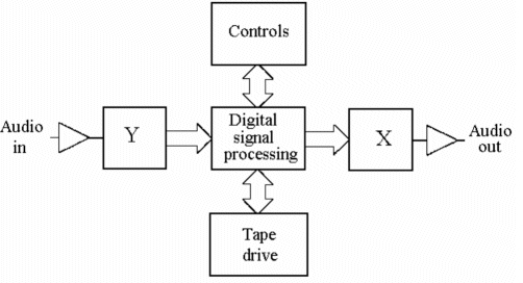
A) Power supply for the audio amplifier
B) Analog- to- digital conversion
C) Audio ON/OFF control
D) Digital- to- analog conversion

A) Power supply for the audio amplifier
B) Analog- to- digital conversion
C) Audio ON/OFF control
D) Digital- to- analog conversion

Unlock Deck
Unlock for access to all 46 flashcards in this deck.
Unlock Deck
k this deck
20
Which of the equations below expresses the voltage gain relationship for an operational amplifier?
A) Vout/Vin = - Rf/Rin
B) Vin/Vout = Rout/Rin
C) Vout = Vin/Av
D) Vout/Vin = Rout/Rin
A) Vout/Vin = - Rf/Rin
B) Vin/Vout = Rout/Rin
C) Vout = Vin/Av
D) Vout/Vin = Rout/Rin

Unlock Deck
Unlock for access to all 46 flashcards in this deck.
Unlock Deck
k this deck
21
What type of op- amp circuit does not typically have a feedback path connected between its output and either of its input pins?
A) A current multiplier
B) An open- loop amplifier
C) An inverter
D) A comparator
A) A current multiplier
B) An open- loop amplifier
C) An inverter
D) A comparator

Unlock Deck
Unlock for access to all 46 flashcards in this deck.
Unlock Deck
k this deck
22
? 
-The circuit shown in Figure 12- 1 is a(n) ________.
A) R/2R ladder D/A converter
B) binary- weighted- input DAC
C) four- bit decoder
D) four- bit A/D converter

-The circuit shown in Figure 12- 1 is a(n) ________.
A) R/2R ladder D/A converter
B) binary- weighted- input DAC
C) four- bit decoder
D) four- bit A/D converter

Unlock Deck
Unlock for access to all 46 flashcards in this deck.
Unlock Deck
k this deck
23
? 
-What is the output from the circuit in Figure 12- 1 at the time marked 'X'?
A) 2.75 V
B) 1.011 V
C) - 1.011 V
D) - 2.75 V

-What is the output from the circuit in Figure 12- 1 at the time marked 'X'?
A) 2.75 V
B) 1.011 V
C) - 1.011 V
D) - 2.75 V

Unlock Deck
Unlock for access to all 46 flashcards in this deck.
Unlock Deck
k this deck
24
The circuit shown below is a(n) _________.
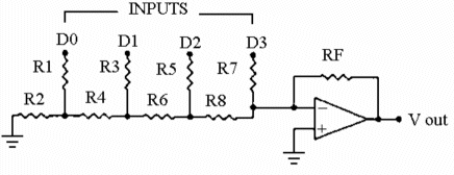
A) four- bit A/D converter
B) R/2R ladder D/A converter
C) binary- weighted- input DAC
D) four- bit decoder

A) four- bit A/D converter
B) R/2R ladder D/A converter
C) binary- weighted- input DAC
D) four- bit decoder

Unlock Deck
Unlock for access to all 46 flashcards in this deck.
Unlock Deck
k this deck
25
What advantage does the R/2R ladder DAC have over a binary- weighted- input DAC?
A) The virtual ground is eliminated and the circuit is therefore easier to understand and troubleshoot.
B) It uses only two different resistor values.
C) It is much easier to analyze its operation.
D) It has fewer parts for the same number of inputs.
A) The virtual ground is eliminated and the circuit is therefore easier to understand and troubleshoot.
B) It uses only two different resistor values.
C) It is much easier to analyze its operation.
D) It has fewer parts for the same number of inputs.

Unlock Deck
Unlock for access to all 46 flashcards in this deck.
Unlock Deck
k this deck
26
What is the resolution of a D/A converter?
A) It is the deviation between the ideal straight- line output and the actual output of the converter.
B) It is the reciprocal of the number of discrete steps in the D/A output.
C) It is the comparison between the actual output of the converter and its expected output.
D) The ability to resolve between forward and reverse steps when sequenced over its entire range of inputs.
A) It is the deviation between the ideal straight- line output and the actual output of the converter.
B) It is the reciprocal of the number of discrete steps in the D/A output.
C) It is the comparison between the actual output of the converter and its expected output.
D) The ability to resolve between forward and reverse steps when sequenced over its entire range of inputs.

Unlock Deck
Unlock for access to all 46 flashcards in this deck.
Unlock Deck
k this deck
27
What is the linearity of a D/A converter?
A) It is the deviation between the ideal straight- line output and the actual output of the converter.
B) It is the ability to resolve between forward and reverse steps when sequenced over its entire range of inputs.
C) It is the reciprocal of the number of discrete steps in the D/A output.
D) It is the comparison between the actual output of the converter and its expected output.
A) It is the deviation between the ideal straight- line output and the actual output of the converter.
B) It is the ability to resolve between forward and reverse steps when sequenced over its entire range of inputs.
C) It is the reciprocal of the number of discrete steps in the D/A output.
D) It is the comparison between the actual output of the converter and its expected output.

Unlock Deck
Unlock for access to all 46 flashcards in this deck.
Unlock Deck
k this deck
28
What is the accuracy of a D/A converter?
A) It is the ability to resolve between forward and reverse steps when sequenced over its entire range of inputs.
B) It is the deviation between the ideal straight- line output and the actual output of the converter.
C) It is the reciprocal of the number of discrete steps in the D/A output.
D) It is the comparison between the actual output of the converter and its expected output.
A) It is the ability to resolve between forward and reverse steps when sequenced over its entire range of inputs.
B) It is the deviation between the ideal straight- line output and the actual output of the converter.
C) It is the reciprocal of the number of discrete steps in the D/A output.
D) It is the comparison between the actual output of the converter and its expected output.

Unlock Deck
Unlock for access to all 46 flashcards in this deck.
Unlock Deck
k this deck
29
What is the resolution, in percent, of a 12- bit DAC?
A) 0.024
B) 0.000488
C) 0.083
D) 8.33
A) 0.024
B) 0.000488
C) 0.083
D) 8.33

Unlock Deck
Unlock for access to all 46 flashcards in this deck.
Unlock Deck
k this deck
30
A simultaneous A/D converter is also known as a/an ________A/D converter.
A) asynchronous
B) flash
C) synchronous
D) comparator
A) asynchronous
B) flash
C) synchronous
D) comparator

Unlock Deck
Unlock for access to all 46 flashcards in this deck.
Unlock Deck
k this deck
31
The primary disadvantage of the simultaneous A/D converter is _________.
A) the long conversion time required
B) the large number of output lines required to simultaneously decode the input voltage
C) the large number of comparators required to represent a reasonable- sized binary number
D) that it requires the input voltage to be applied to the inputs simultaneously
A) the long conversion time required
B) the large number of output lines required to simultaneously decode the input voltage
C) the large number of comparators required to represent a reasonable- sized binary number
D) that it requires the input voltage to be applied to the inputs simultaneously

Unlock Deck
Unlock for access to all 46 flashcards in this deck.
Unlock Deck
k this deck
32
What is the main disadvantage of the stairstep- ramp A/D converter?
A) It requires a precision clock in order for the conversion to be reliable.
B) It requires a counter.
C) The counter must count up from zero at the beginning of each conversion sequence, so the conversion time varies with the input voltage.
D) All of the above are correct.
A) It requires a precision clock in order for the conversion to be reliable.
B) It requires a counter.
C) The counter must count up from zero at the beginning of each conversion sequence, so the conversion time varies with the input voltage.
D) All of the above are correct.

Unlock Deck
Unlock for access to all 46 flashcards in this deck.
Unlock Deck
k this deck
33
The figure below represents a _________.
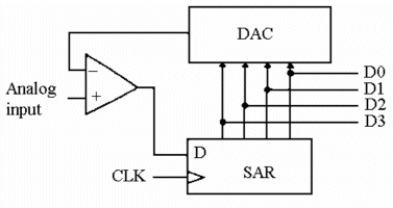
A) tracking A/D converter
B) successive- approximation A/D converter
C) dual- approximation D/A comparator
D) dual- slope A/D converter

A) tracking A/D converter
B) successive- approximation A/D converter
C) dual- approximation D/A comparator
D) dual- slope A/D converter

Unlock Deck
Unlock for access to all 46 flashcards in this deck.
Unlock Deck
k this deck
34
The main advantage that a tracking A/D converter has over a stairstep- ramp A/D converter is that it ________.
A) uses an up/down counter to allow it to measure both positive and negative voltages
B) is faster
C) does not require a counter
D) uses an up/down counter to indicate the polarity of the input voltage
A) uses an up/down counter to allow it to measure both positive and negative voltages
B) is faster
C) does not require a counter
D) uses an up/down counter to indicate the polarity of the input voltage

Unlock Deck
Unlock for access to all 46 flashcards in this deck.
Unlock Deck
k this deck
35
One disadvantage of the tracking A/D converter is ________.
A) the need for an accurate clock reference for the counter
B) the binary output will oscillate between two binary states when the analog input is constant
C) the need for a latch and its associated control circuit
D) it requires two counters: one for up and one for down
A) the need for an accurate clock reference for the counter
B) the binary output will oscillate between two binary states when the analog input is constant
C) the need for a latch and its associated control circuit
D) it requires two counters: one for up and one for down

Unlock Deck
Unlock for access to all 46 flashcards in this deck.
Unlock Deck
k this deck
36
Which of the following describes the basic operation of a single- slope A/D converter?
A) A ramp generator is used to enable a counter through a comparator. When the ramp voltage equals the input voltage the counter is latched and then reset. The counter reading is proportional to the input voltage since the ramp is changing at a constant V/second rate.
B) A ramp voltage and analog input voltage are applied to a comparator. As the input voltage causes the integrating capacitor to charge, it will at some point equal the ramp voltage. The ramp voltage is measured and displayed on the digital panel meter.
C) The input voltage is used to set the frequency of a voltage- controlled oscillator (VCO). The VCO quits changing frequency when the input voltage stabilizes. The frequency of the VCO, which is proportional to the analog input voltage, is measured and is displayed on the digital display as a voltage reading.
D) Any of the above could be correct, depending on the specific type of A/D converter involved.
A) A ramp generator is used to enable a counter through a comparator. When the ramp voltage equals the input voltage the counter is latched and then reset. The counter reading is proportional to the input voltage since the ramp is changing at a constant V/second rate.
B) A ramp voltage and analog input voltage are applied to a comparator. As the input voltage causes the integrating capacitor to charge, it will at some point equal the ramp voltage. The ramp voltage is measured and displayed on the digital panel meter.
C) The input voltage is used to set the frequency of a voltage- controlled oscillator (VCO). The VCO quits changing frequency when the input voltage stabilizes. The frequency of the VCO, which is proportional to the analog input voltage, is measured and is displayed on the digital display as a voltage reading.
D) Any of the above could be correct, depending on the specific type of A/D converter involved.

Unlock Deck
Unlock for access to all 46 flashcards in this deck.
Unlock Deck
k this deck
37
Which of the statements below best describes the basic operation of a dual- slope A/D converter?
A) The input voltage is used to set the frequency of a voltage- controlled oscillator (VCO). The VCO quits changing frequency when the input voltage stabilizes. The frequency of the VCO, which is proportional to the analog input voltage, is measured and is displayed on the digital display as a voltage reading.
B) A ramp voltage and analog input voltage are applied to a comparator. As the input voltage causes the integrating capacitor to charge, it will at some point equal the ramp voltage. The ramp voltage is measured and displayed on the digital panel meter.
C) A ramp generator is used to enable a counter through a comparator. When the ramp voltage equals the input voltage the counter is latched and then reset. The counter reading is proportional to the input voltage since the ramp is changing at a constant V/second rate.
D) Two ramps are generated: one by the input voltage and the other by a reference voltage. The input voltage ramp charges the integrating capacitor, while the reference voltage discharges the capacitor and enables the counter until the capacitor is discharged, at which time the counter value is loaded into the output latches.
A) The input voltage is used to set the frequency of a voltage- controlled oscillator (VCO). The VCO quits changing frequency when the input voltage stabilizes. The frequency of the VCO, which is proportional to the analog input voltage, is measured and is displayed on the digital display as a voltage reading.
B) A ramp voltage and analog input voltage are applied to a comparator. As the input voltage causes the integrating capacitor to charge, it will at some point equal the ramp voltage. The ramp voltage is measured and displayed on the digital panel meter.
C) A ramp generator is used to enable a counter through a comparator. When the ramp voltage equals the input voltage the counter is latched and then reset. The counter reading is proportional to the input voltage since the ramp is changing at a constant V/second rate.
D) Two ramps are generated: one by the input voltage and the other by a reference voltage. The input voltage ramp charges the integrating capacitor, while the reference voltage discharges the capacitor and enables the counter until the capacitor is discharged, at which time the counter value is loaded into the output latches.

Unlock Deck
Unlock for access to all 46 flashcards in this deck.
Unlock Deck
k this deck
38
The basic approach to testing D/A converters is to ________.
A) apply a sequence of binary codes covering the full range of the input to the input while observing the output on an oscilloscope. The output should consist of a linear stairstep ramp
B) single- step the device through its full input range while checking the output with a DMM
C) apply the correct input to the analog terminal and then check to see if the proper binary code exists on the digital inputs
D) check the output with zero input and then full input. The output of the converter should extend from zero to its maximum value. If so, then everything in between can be assumed to be operating properly
A) apply a sequence of binary codes covering the full range of the input to the input while observing the output on an oscilloscope. The output should consist of a linear stairstep ramp
B) single- step the device through its full input range while checking the output with a DMM
C) apply the correct input to the analog terminal and then check to see if the proper binary code exists on the digital inputs
D) check the output with zero input and then full input. The output of the converter should extend from zero to its maximum value. If so, then everything in between can be assumed to be operating properly

Unlock Deck
Unlock for access to all 46 flashcards in this deck.
Unlock Deck
k this deck
39
Refer to the figure below. What, if anything, appears to be wrong with the output of the D/A converter? 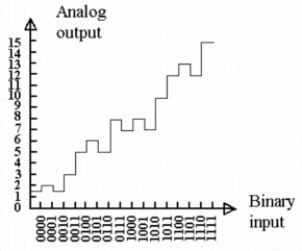
A) It appears that certain input codes are incorrect; double- check the input coding.
B) There appears to be some nonlinearity in the scope display.
C) The converter has a nonmonotonic output error.
D) The input signal is probably noisy.

A) It appears that certain input codes are incorrect; double- check the input coding.
B) There appears to be some nonlinearity in the scope display.
C) The converter has a nonmonotonic output error.
D) The input signal is probably noisy.

Unlock Deck
Unlock for access to all 46 flashcards in this deck.
Unlock Deck
k this deck
40
? 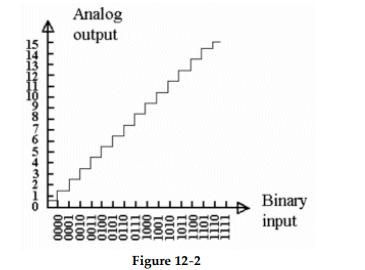
-Refer to Figure 12- 2. What, if anything, appears to be wrong with the D/A converter?
A) There is an offset error.
B) There is nothing wrong with the converter.
C) The power supply voltage appears to be too high.
D) There is a nonlinearity error.

-Refer to Figure 12- 2. What, if anything, appears to be wrong with the D/A converter?
A) There is an offset error.
B) There is nothing wrong with the converter.
C) The power supply voltage appears to be too high.
D) There is a nonlinearity error.

Unlock Deck
Unlock for access to all 46 flashcards in this deck.
Unlock Deck
k this deck
41
Refer to the figure below. What should the display on the scope look like if the A/D converter is working properly? 
A) The pattern should be a straight line across the screen due to the equal but opposite voltages being applied to the scope inputs.
B) The scope should display a sequential binary count with the LSB being on the left and the MSB on the right side of the display.
C) A uniform stairstep pattern should be displayed.
D) It should be a circular Lissajous pattern resulting from the simultaneous application of ramps to the vertical and horizontal inputs of the oscilloscope.

A) The pattern should be a straight line across the screen due to the equal but opposite voltages being applied to the scope inputs.
B) The scope should display a sequential binary count with the LSB being on the left and the MSB on the right side of the display.
C) A uniform stairstep pattern should be displayed.
D) It should be a circular Lissajous pattern resulting from the simultaneous application of ramps to the vertical and horizontal inputs of the oscilloscope.

Unlock Deck
Unlock for access to all 46 flashcards in this deck.
Unlock Deck
k this deck
42
Sigma- Delta ADC utilizes ________.
A) a one- bit quantization method
B) quantized difference between two samples
C) delta modulation
D) all of the above
A) a one- bit quantization method
B) quantized difference between two samples
C) delta modulation
D) all of the above

Unlock Deck
Unlock for access to all 46 flashcards in this deck.
Unlock Deck
k this deck
43
DSPs are programmed in ________.
A) assembly language
B) ABEL
C) visual basic
D) none of the above
A) assembly language
B) ABEL
C) visual basic
D) none of the above

Unlock Deck
Unlock for access to all 46 flashcards in this deck.
Unlock Deck
k this deck
44
DSP applications include ________.
A) telecommunications
B) radar
C) speech generation
D) all of the above
A) telecommunications
B) radar
C) speech generation
D) all of the above

Unlock Deck
Unlock for access to all 46 flashcards in this deck.
Unlock Deck
k this deck
45
DSP applications include ________.
A) image processing
B) music processing
C) filtering
D) all of the above
A) image processing
B) music processing
C) filtering
D) all of the above

Unlock Deck
Unlock for access to all 46 flashcards in this deck.
Unlock Deck
k this deck
46
The CPU of the DSP is also known as ________.
A) the general- purpose registers
B) the ALU
C) the DSP core
D) the MIPS
A) the general- purpose registers
B) the ALU
C) the DSP core
D) the MIPS

Unlock Deck
Unlock for access to all 46 flashcards in this deck.
Unlock Deck
k this deck



